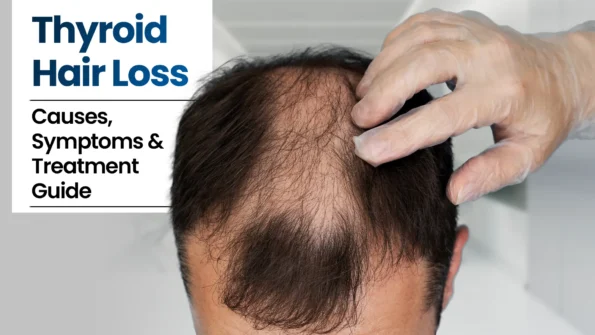Thyroid disorders are common, especially in women; women are about 8 times more likely to develop thyroid issues compared to men. When the thyroid gland goes out of balance (either overactive or underactive), it can profoundly affect your body’s metabolism, hormones, and yes your hair. When thyroid hormones shift, they can disturb the hair growth cycle, leading to diffuse thinning or shedding.
This guide will break down the intricate link between your thyroid and hair, explore other potential causes of hair loss, and outline a clear path toward treatment and regrowth.
How Hair Grows: The Hair Cycle
To understand how thyroid imbalances lead to hair loss, it helps to first understand the normal hair growth cycle. Our scalp hair doesn’t grow all at once — it follows repeating phases:
- Anagen (growth phase) — ~ 90% of scalp hairs are in this phase at any time. It can last 2 to 6 years, during which hair follicles receive ample blood supply and nutrients.
- Catagen (transition phase) — ~ 1% of hair enters this short 1–2 week phase when growth slows and the follicle begins to shrink.
- Telogen (resting/shedding phase) — ~ 8–9% of hair is in this phase, lasting 3 to 6 months or longer. At the end, hair naturally falls out, making way for new growth.
Shedding of 50 to 100 hairs per day is considered normal. But when hair loss crosses 100, 150, or more, it may indicate an underlying issue.
Thyroid and Hair Loss: What Science Says
The connection between thyroid dysfunction and hair loss is well documented in endocrinology and dermatology literature.
- Thyroid hormones (T₃, T₄) directly target human hair follicles, influencing cycling, pigmentation, and keratinocyte proliferation.
- Both hypothyroidism (underactive thyroid) and hyperthyroidism (overactive thyroid) can cause diffuse hair shedding rather than patchy bald spots.
- In hypothyroid patients, the ratio of telogen to anagen hairs shifts, causing more hairs to remain in the resting (telogen) phase and eventually fall out.
- Some studies show that thyroid dysfunction is a common cause of telogen effluvium (TE), a type of hair loss characterized by diffuse shedding.
- Moreover, people with thyroid disorders (especially hypothyroidism) are more likely to also have autoimmune hair loss like alopecia areata.
In short, when your thyroid is out of balance, it can push more hairs into the resting (telogen) state or prevent new hairs from entering the growth (anagen) phase, resulting in thinning, shedding, and slower regrowth.
What Thyroid-Related Hair Loss Looks Like
Here are some hallmarks to watch for:
- Diffuse thinning (hair loss all over the scalp) rather than patchy bald spots
- Reduced hair volume, changes in hair texture (becomes dry, brittle)
- Eyebrow thinning, especially the outer third, known as Hertoghe’s sign, a recognized sign in hypothyroidism.
- Hairfall can also affect body hair, eyelashes, and eyebrows
- Often uniform hair shedding when brushing or shampooing
Note: In autoimmune thyroid disease cases, patchy patterns (like alopecia areata) may also occur.
Why Hairfall Sometimes Worsens After You Start Thyroid Medicine
Many people fear that starting thyroid medications causes hair fall. However, what actually happens is:
- Hair follicles respond slowly; hair you shed today may have entered the resting phase months ago.
- Your thyroid imbalance likely predates your medicine by months or years, and the shedding was “waiting” to appear.
- Thus, the onset of hair loss after starting treatment is often coincidental, not causal.
- Stopping medication is not advised; uncontrolled thyroid levels will worsen hair loss and other health issues.
If you worry that your medication is contributing, talk to your doctor; they can check dosage and adjust as needed.
Other Causes of Hair Loss: Don’t Blame Thyroid Only
While thyroid disorders are a significant cause, many other factors can trigger or worsen hair fall. Often, multiple causes coexist:
- Hormonal imbalances (e.g., PCOS, androgen excess)
- Nutritional deficiencies (iron/hemoglobin, vitamin B complex, vitamin D, zinc, copper, CoQ10)
- Sudden weight loss or crash diets
- Stress (emotional or physical)
- Trauma, surgery, high fever, infections
- Scalp conditions (fungal infections, dandruff)
- Tight hairstyles / traction alopecia
- Certain medications (e.g., oral contraceptives, blood thinners)
- Autoimmune diseases (e.g., lupus, alopecia areata)
When diagnosing hair loss, doctors consider all these angles, it’s rarely a single cause.
How to Address Thyroid-Related Hair Loss: A Step-by-Step Plan
Here’s a comprehensive, evidence-based approach to tackling hair fall when thyroid is involved.
1. Achieve & Maintain Optimal Thyroid Levels
- Work with an endocrinologist or hormone specialist to find your “optimum” range, not just “normal” lab values.
- For hypothyroidism, levothyroxine is commonly used; for hyperthyroidism, options include antithyroid meds, radioactive iodine, or surgery.
- Monitor TSH, free T₃, free T₄, and, if needed antibody tests.
- Even if labs fall within the “normal” range, your thyroid may not yet be ideal for hair regrowth.
2. Screen for & Correct Other Health Issues
- Get blood tests for hemoglobin, ferritin (iron stores), vitamin B levels, vitamin D, zinc, copper, etc.
- If any deficiency is found, correct it with guidance from your doctor.
- Also look for signs of PCOS, elevated androgens, or other hormonal imbalances and treat accordingly.
3. Nutrition & Diet
- Prioritize high-quality protein (vegetarian or non-vegetarian). Your hair is made of keratin, a protein.
- Include anti-inflammatory foods: turmeric, ginger, green leafy vegetables, berries.
- Limit processed foods, excess sugar, highly refined grains these can promote systemic inflammation, which worsens hair loss.
- Stay hydrated and maintain balanced macros (good fats, carbs, proteins).
4. Use Micronutrients Wisely (Supplements with Caution)
- Biotin is often touted for hair, but excessive intake (thousands of micrograms) may interfere with thyroid lab tests and even potentially worsen issues.
- Multivitamins that include B-complex, zinc, copper, vitamin C, E, CoQ10 may help.
- Always use pharmaceutical-grade / verified supplements, and only under medical supervision.
5. Manage Stress & Lifestyle
- Stress can shift your body into a “hair shedding” mode (telogen effluvium).
- Practices like yoga, meditation, breathing exercises (pranayama), music therapy, journaling can help reduce stress hormone levels.
- Sleep, gentle exercise, and self-care are foundational.
6. Be Gentle with Your Hair
- Avoid tight hairstyles, pulling, harsh chemical treatments.
- Use wide-toothed combs / soft brushes, and avoid excessive heat.
- Consider gentle scalp massage to improve blood flow, but don’t overdo it.
7. Patience is Key + When to See a Specialist
- Hair regrowth is slow. Even after achieving hormonal balance, it can take several months or more to see visible improvement.
- The new growth may differ in texture or color. Full recovery to previous hair status isn’t guaranteed.
- If you don’t see meaningful improvement over months, consider visiting a trichologist (hair specialist). They may recommend PRP, micro-needling, hair transplant, or advanced therapies based on your case.
Putting It All Together: A Realistic Timeline
Timeframe | What to Expect / Action |
Month 0 | Begin thyroid evaluation + lab tests; correct nutritional deficits |
Months 1–3 | Adjust thyroid meds + repair deficiencies; mild shedding may continue |
Months 3–6 | Early regrowth begins; hair is soft, shorter, delicate |
Months 6–12+ | Gradual improvement in density, texture, volume |
After 12 months | Evaluate progress; consider specialist interventions if needed |
Final Thoughts
Hair loss linked to thyroid imbalance is a real and treatable condition. The path to recovery involves:
- Bringing thyroid hormones into an optimal range
- Correcting co-factors (nutritional, hormonal, lifestyle)
- Being gentle with your hair
- Having patience and consistency
With time and a holistic approach, many people see meaningful regrowth and healthier, stronger hair. If you ever feel stuck or discouraged, consulting a specialist (endocrinologist + trichologist) is worth it. You’re not alone many have walked this path and regained their hair confidence.
Regain Your Confidence with Hairfree & Hairgrow Clinic
If you’re struggling with hair loss due to thyroid imbalance, don’t wait for it to get worse let the experts at Hairfree & Hairgrow Clinic help you.
Our team of experienced trichologists and hair restoration specialists use advanced diagnostic tools and proven treatments to identify the root cause and design a personalized plan for your hair regrowth journey.
Whether you’re dealing with thyroid-related hair fall, hormonal imbalance, or long-term thinning, we’re here to guide you every step of the way from diagnosis to visible results.
Visit your nearest Hairfree & Hairgrow Clinic in Pune, Mumbai, Hyderabad, Ahmedabad, Gurugram, Kolkata, Indore, Bhopal, Nagpur, or Vapi, or Book a consultation today to take the first step toward healthy, strong, and beautiful hair.
FAQs
1. Can thyroid problems really cause hair loss?
Yes. Both hypothyroidism (low thyroid function) and hyperthyroidism (overactive thyroid) can cause diffuse hair thinning across the scalp. Thyroid hormones play a key role in the hair growth cycle, and when they’re out of balance, more hair enters the resting (telogen) phase, leading to shedding and slower regrowth.
2. How do I know if my hair loss is due to thyroid issues?
If you notice even, overall thinning instead of patchy bald spots, along with other thyroid symptoms like fatigue, weight changes, cold intolerance, or dry skin, thyroid dysfunction could be a cause. A blood test for TSH, T3, and T4 is the best way to confirm whether your thyroid is contributing to your hair loss.
3. Will my hair grow back after thyroid treatment?
In most cases, yes, once your thyroid hormone levels are stabilized and deficiencies are corrected, hair regrowth begins within 3 to 6 months. However, the process is gradual and may take up to a year or longer to regain full volume. Patience and consistent follow-up with your doctor are key.
4. Can thyroid medications cause hair loss?
Some people notice hair shedding soon after starting thyroid medication, but this is usually temporary. The shedding is often due to the body adjusting to new hormone levels, not the medicine itself. Continuing your prescribed treatment will help hair recover in the long term.
5. What are the best treatments for thyroid-related hair loss?
The best approach is treating the root cause, keeping thyroid levels balanced. Along with medical treatment, focus on:
- Eating a protein-rich, nutrient-dense diet (iron, zinc, B-vitamins, vitamin D)
- Managing stress and improving sleep
- Avoiding tight hairstyles and harsh chemicals
- Using gentle, dermatologist-recommended hair products
If needed, a trichologist may suggest PRP therapy, microneedling, or supplements to boost regrowth.
Written By
MD (Skin & VD)
Dr. Richa Sanmukhani is a renowned hair restoration specialist with expertise in Thyroid Hair Loss. She combines advanced diagnostic techniques and personalized treatment plans to restore hair health and confidence, helping patients effectively manage hair thinning caused by thyroid imbalances with holistic, results-driven care.
Disclaimer
We’ve made all possible efforts to ensure that the information provided here is accurate, up-to-date and complete, however, it should not be treated as a substitute for professional medical advice, diagnosis or treatment. See Detailed Disclaimers Here.



